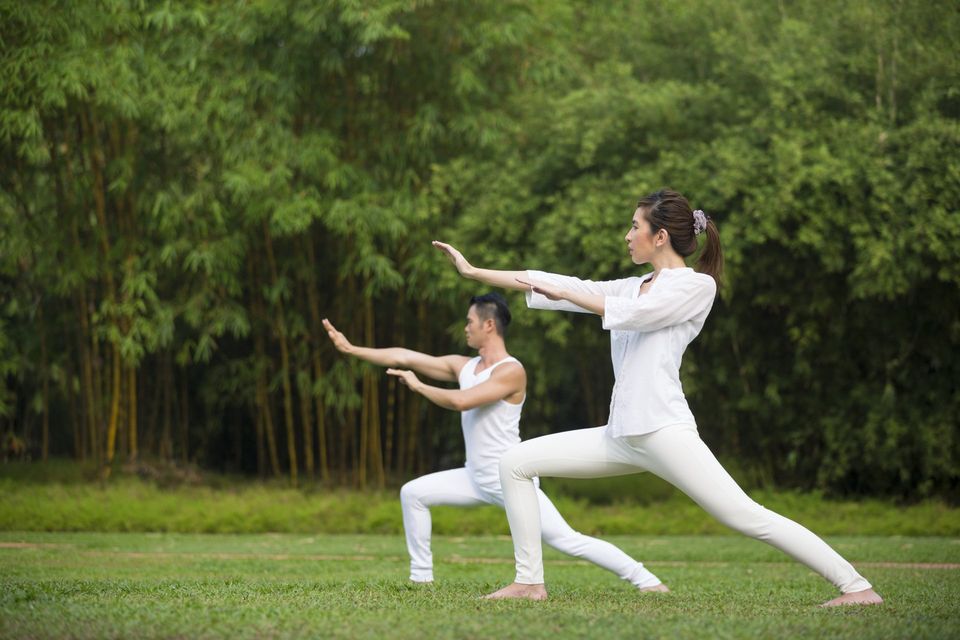9 BENEFITS OF TAI CHI

It's not hard to understand why the ancient Chinese practice of tai chi has gained popularity in the Western world. While it can't make you younger, it can purportedly prevent or treat ailments and chronic conditions that often come with aging. People practice tai chi for any number of reasons, ranging from easing joint pain and preventing falls to achieving a feeling of overall well-being.
"Tai chi's gentle, fluid movements make it ideal for people who want the benefits of exercise without strain or jarring impacts," says Carolyn M. Matthews, M.D., director of Integrative and Functional Medicine at Baylor University Medical Center at Dallas. "Its convenience is appealing, too; you can practice it nearly anywhere -- either alone or in a group -- and no equipment is needed."
Tai chi (full name: tai chi chuan) originated in China centuries ago as a martial art. It was an outgrowth of the ancient Taoist philosophy, which values tranquility and reflection. As typically practiced today, tai chi is a mind-body practice that combines elements of a workout, meditation, and dance. You might have seen groups performing tai chi in synchrony outdoors under the guidance of an instructor.
Tai chi consists of slow, balanced, low-impact movements performed in sequences known as sets or forms. The postures and gestures are derived from animal movements. To do them correctly, you must learn controlled breathing, concentration, how to shift your body weight, and how to relax your muscles.
THE SCIENCE BEHIND TAI CHI
Growing scientific evidence suggests that tai chi may help improve some aspects of both physical and mental health. However, studies of tai chi are often small, have design limitations, and vary widely in frequency and duration, which makes it difficult for researchers to draw conclusions.
"While tai chi should not be used to replace conventional care," says Youcef Sennour, a geriatrics and internal medicine specialist at Baylor Senior Health Center in Dallas, "it can play an important role as a complementary therapy when it comes to treating conditions commonly associated with aging."
Here's a sampling of findings from studies that have looked at the health benefits associated with practicing tai chi:
1. BETTER BALANCE, FEWER FALLS
"Much research has shown that tai chi can improve balance and coordination, reducing the risk of falls or fear of falling in older adults," Dr. Sennour says. Guidelines for fall prevention in older people from the American Geriatrics Society and its British counterpart recommend tai chi because it target strength, gait, and balance. The Vestibular Disorders Association notes that it can improve balance by strengthening and stabilizing the ankles; encouraging equally distributed movement between the ankle, knee, and hip joints; and promoting a greater awareness of the body and movement. A study in the Journal of the American Geriatrics Society compared two groups of people with an average age of 60 who had a fall that sent them to the emergency room at least half a year before. One group took a tai chi class afterward; the other had conventional balance training and exercises to increase strength and flexibility in their legs and feet. Over the next 18 months, the people who took tai chi had an average of 0.8 falls each compared with 1.0 falls in the other group. Additionally, a clinical trial found tai chi to be more effective than resistance training or stretching for improving balance and stability among people with mild to moderate Parkinson's disease.
2. KNEE ARTHRITIS RELIEF
A review of six clinical trials, published in the Journal of Physical Therapy Science, found "some strong evidence" suggesting that tai chi could help control pain and improve physical function in people (average age, 60) with knee osteoarthritis. It also found evidence that the practice could improve balance and strength. The authors noted that larger, longer trials are needed to confirm those benefits. And tai chi may work at least as well as conventional physical therapy. A trial published in the Annals of Internal Medicine compared a group doing tai chi with a group getting physical therapy for knee osteoarthritis. The two groups improved about equally in pain, physical function, and stiffness, but the tai chi group showed better effects on their depression and quality of life than the physical therapy group.
3. A BOOST IN BRAIN POWER
A study in the Journal of Alzheimer's Disease, which included 120 healthy older people in China, those who practiced tai chi three times a week for 40 weeks showed increases in brain volume and improvements on several tests of memory and learning, compared with those not doing the exercise. In a review of 20 studies of older healthy adults in the Journal of the American Geriatrics Society, researchers suggested that tai chi could enhance the ability to reason, plan, remember, and solve problems. They also surmise that tai chi might benefit people with cognitive impairment, although larger trials are needed before conclusions can be drawn.
4. LESS DEPRESSION AND ANXIETY
Tai chi showed positive effects on various measures of psychological well-being, including reduced depression and anxiety and better stress management, according to a systematic review of 42 studies in the International Journal of Behavioral Medicine. And tai chi yielded statistically significant reductions in anxiety symptoms in 12 of 17 studies included in a review in the Journal of Evidence-Based Complementary & Alternative Medicine. However, one review found that tai chi was less effective than other techniques, such as stress reduction, in alleviating depression in patients with breast cancer.
5. BETTER HEART HEALTH
A review of tai chi for diseases of the heart and blood vessels published in the Journal of the American Heart Association found multiple studies showing that tai chi (and the related traditional Chinese practices of qigong and baduanjin) could decrease blood pressure. People practicing those disciplines lowered their systolic blood pressure (the top number) by 9.12 mm Hg and diastolic blood pressure (the bottom number) by 5.12 mm Hg on average. The traditional Chinese practices also increased the distance people could walk in six minutes by about 60 yards. Additionally, the exercises were associated with a small drop in low-density lipoprotein cholesterol (the "bad" kind) and triglycerides (fat in the blood that increases heart disease and stroke risk) and improved quality of life and mood.
6. CHRONIC PAIN RELIEF
Tai chi can ease chronic pain, according to researchers reporting in the Journal of Pain. They randomly assigned people with neck pain to tai chi, conventional neck exercises, or a waiting list. After 12 weeks, the people in both the tai chi and neck exercise groups reported less pain and better quality of life than the people on the waiting list. The authors suggested that if more research confirms those results, tai chi could appeal to people with neck pain who might prefer it to conventional exercises.
7. IMPROVEMENTS IN FIBROMYALGIA
A few studies have suggested that tai chi can help with the symptoms of fibromyalgia, a chronic disorder that causes fatigue and widespread aches, tenderness, and pain in the muscles and bones. In one study, reported in the New England Journal of Medicine, participants with an average age of 50 who took tai chi had a greater reduction in pain and more improvement in mood, quality of life, and ability to exercise than another group who took classes in managing fibromyalgia and did stretching exercises.
8. BENEFITS FOR CHRONIC CONDITIONS
A group of Canadian researchers sought to determine the effectiveness of tai chi in common chronic conditions found in older adults. They analyzed 33 studies that encompassed 1,584 patients ranging in age from the mid-50s to the early 70s who had one of four chronic conditions: breast cancer, osteoarthritis, heart failure, and chronic obstructive pulmonary disease. In the British Journal of Sports Medicine, they reported that tai chi was associated with improvements in muscle strength and physical capacity, such as the time it takes to get up from a chair and the distance walked in six minutes, in most or all chronic conditions. Tai chi was also associated with reduced stiffness and pain in people with osteoarthritis and slight breathing improvements in people with COPD. The average patient participated in tai chi for an hour, two or three times a week for 12 weeks.
9. AND EVEN MORE
Clinical trials have suggested a favorable effect on bone density and health. Other studies have associated tai chi with better sleep quality, a stronger immune system, improved blood glucose levels, back pain relief, and an improved quality of life in people with heart failure, cancer, COPD, and other chronic, debilitating medical conditions. Tai chi classes can also be a relaxing means of socializing.
A SAFE PRACTICE
Tai chi is generally safe for people of all ages, Dr. Matthews says. "The practice is easy on the joints and muscles and unlikely to result in serious injury, though beginners may sometimes report minor aches and pains."
You should avoid practicing tai chi on a full stomach or when you're very tired. If you have joint problems, back pain, a hernia, or osteoporosis, consult with your doctor before taking up the practice. He or she may recommend modifying or avoiding certain postures that may exacerbate your condition.
"With proper training, even the most sedentary among us can safely embark on a program of tai chi," Dr. Sennour says.
